- | Regulation Regulation
- | State Testimonies State Testimonies
- |
Arizona Occupational Licensing: Barriers to Opportunity in the Grand Canyon State
Testimony before the Arizona State Legislature, Senate Committee on Military & Veterans Affairs
Chair Lawrence, Vice Chair Osborne, and distinguished members of the Senate Committee on Military & Veterans Affairs:
My name is Matthew Mitchell. I am an economist and a senior research fellow at the Mercatus Center at George Mason University, where I direct the Equity Initiative. Mercatus scholars working on the Equity Initiative study public policies that favor particular firms, industries, or occupations. In recent years, my colleagues and I have been studying occupational licensing laws, and I am grateful for the opportunity to discuss our findings with you.
In my testimony, I wish to focus on three points:
- Licensing is a substantial barrier to employment, particularly for certain populations such as military spouses.
- Licensing does little to enhance either consumer safety or the quality of services; it does, however, increase prices for consumers.
- Successful reform is difficult, but not impossible. Policymakers must be able to cast conspicuous votes in the general interest while special interest power must be limited.
Licensure Is a Substantial Barrier to Employment
Licensing represents a significant and growing barrier to work. Nationally, the share of the workforce that is required to have an occupational license has increased more than fourfold in the past 50 years. As of 2015, nearly one in four working Arizonans—22.3 percent of the state’s workforce—was required to be licensed.
As licensing burdens have increased nationwide, they seem to have depressed interstate migration of those in licensed professions. Economists Janna Johnson and Morris Kleiner estimate that between-state migration of those who are licensed is 36 percent lower than that of members of other professions.
These burdens have an economic cost. In separate research, Kleiner and Evgeny Vorotnikov estimate that licensure may cost between 1.8 and 1.9 million jobs, result in between $6.2 billion and $7.1 billion in lost output, and create a misallocation of resources that costs the US economy between $183.9 billion and $197.3 billion each year. In Arizona alone, they estimate that licensure has eliminated more than 29,000 jobs, has resulted in $85.2 million in lost annual output, and has created a $2.8 billion annual misallocation of resources.
Aspiring entrants to a large number of professions—ranging from travel guide and door repair contractor to cosmetologist—are now required by the state of Arizona to obtain a government-issued license to work. It can take months and hundreds or even thousands of dollars to obtain these licenses. Among 68 low- to moderate-income occupations licensed by Arizona, the average aspiring worker is required to spend 765 days in training and pay $612 in fees before he or she may obtain a license. This does not count either the cost of the education or the income that people forgo when they spend months in often-unnecessary training. According to the Institute for Justice, Arizona’s licensing laws are the fourth-most-burdensome in the country.
Licensure is often arbitrary. As shown in table 1, licensing requirements often don’t match the risk posed to the public by certain professions. Compared with emergency medical technicians, aspiring cosmetologists in Arizona must undergo 14 times as many months of training; would-be sign language interpreters (who are unlicensed in 28 states) must complete more than 57 times as much training; and commercial door repair contractors (unlicensed in 26 states) must complete more than 56 times as much training.
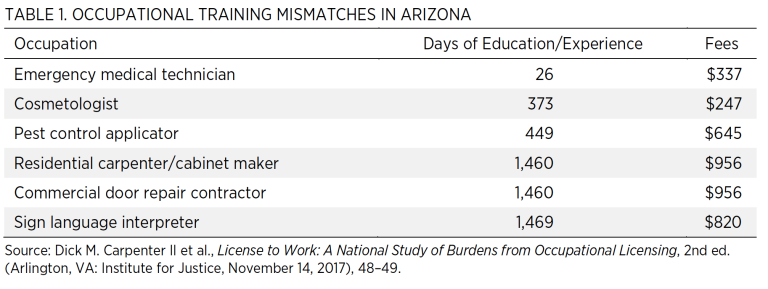
Licensing boards are dominated by members of the professions they oversee. About 85 percent of Arizona occupational licensure boards are required by law to have a majority of their members work in the professions they oversee. See table 2 for board composition data in a sample of Arizona boards. Owing to vacancies, many boards are composed entirely of industry insiders. This presents a legal concern in light of the US Supreme Court’s decision in North Carolina State Board of Dental Examiners v. FTC, which held that states may be liable for antitrust violations when boards are dominated by members of the professions they oversee and when elected officials fail to actively supervise these boards. It also creates a practical concern that boards will tend to act as industry cartels, controlling entry of new members rather than ensuring public safety.
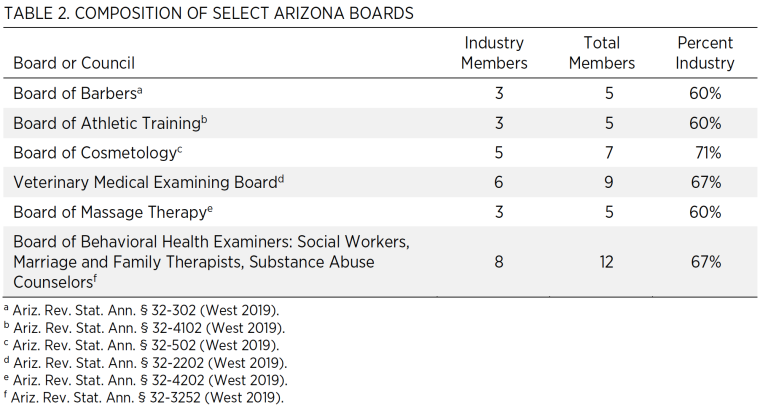
Licensing reduces employment opportunities, especially among certain communities. High barriers to employment pose particular difficulties to lower-skilled, lower-educated populations, to immigrants, to non-English speakers, to those with criminal records, and to those who move frequently, such as military spouses. As shown in figure 1, 80 percent of the studies Mercatus scholars reviewed find that licensure has a disparate impact on minorities.
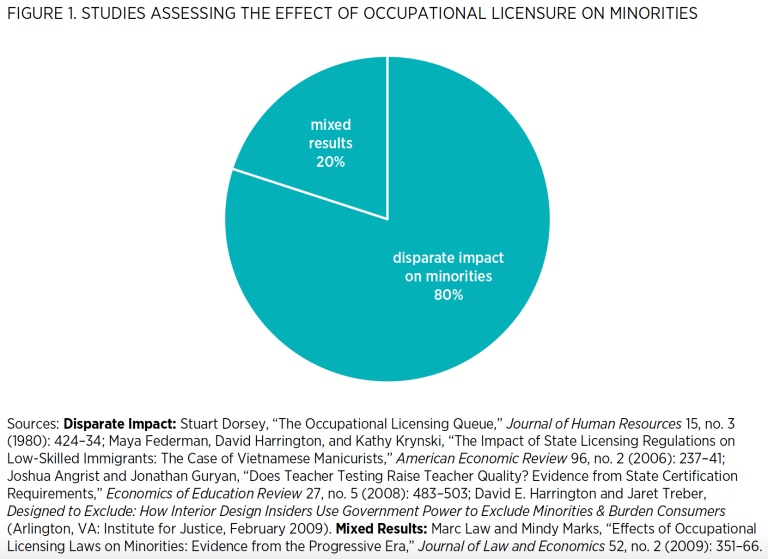
Recent research finds that in countries with more barriers to entering business, measured income inequality is greater. Separate research finds that in states with greater growth in licensure for low- to moderate-income occupations, there is less absolute income mobility, as measured by the chances that an individual raised in a relatively low-income household will move up the income distribution.
Those with criminal histories are particularly likely to be stymied by these laws. The Council of State Governments Justice Center estimates that nationally about 15,000 laws and regulations limit the ability of those with prior convictions to obtain state occupational licenses. Among these, 6,000 are blanket or mandatory restrictions.
Licensure presents an especially steep employment barrier for military spouses. About 35 percent of working military spouses are either licensed or certified. And compared with the broader population, military spouses are 10 times more likely to have moved across a state line in the past year. When military spouses were asked to name the biggest challenges to employment, 22 percent identified the inability to transfer their professional licenses from one state to another. This helps to explain why, in 2017, the military spouse unemployment rate was 16 percent, nearly four times the national average.
Licensure Does Not Seem to Increase Quality or Safety but It Does Raise Prices
The most common justification for occupational licensing is that it is necessary to ensure quality and safety. Unfortunately, it seems to fall short in attaining these goals. In theory, licensure could increase the quality and safety of services if it were to successfully screen out low-quality workers, equip workers with the skills to perform their jobs safely, or both. On the other hand, theory also suggests that licensure could decrease quality and safety. This could happen in two ways: First, licensure may insulate service providers from market competition, and quality tends to be enhanced by market competition. Second, by raising prices and limiting the quantity of providers, licensure may reduce the availability of needed services. In some cases, this can lead to tragedy. For example, when there are fewer electricians in an area, homeowners are more inclined to perform their own electrical work, leading to more injuries.
Because the economic theory is ambiguous, one must turn to the data. In figure 2 I present a survey of the empirical work on licensure and quality. Most studies find that licensure either has mixed, unclear, or neutral effects on quality. Interestingly, however, more studies find a negative effect of licensure on quality than find a positive effect.
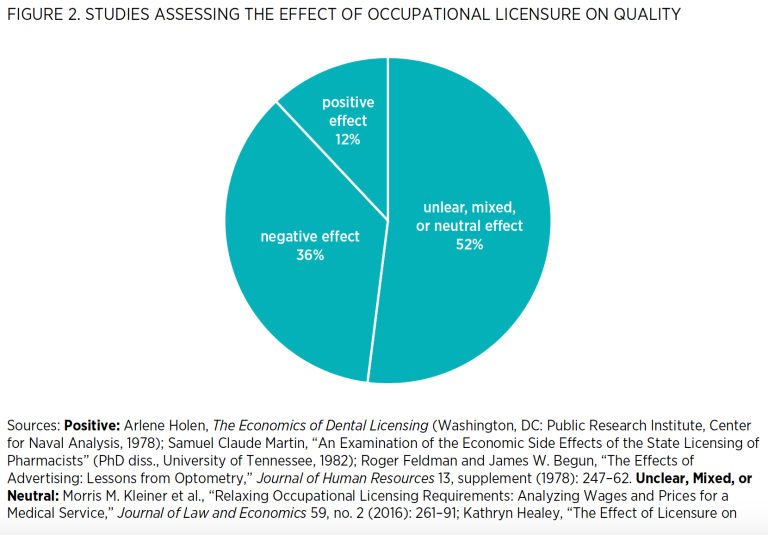
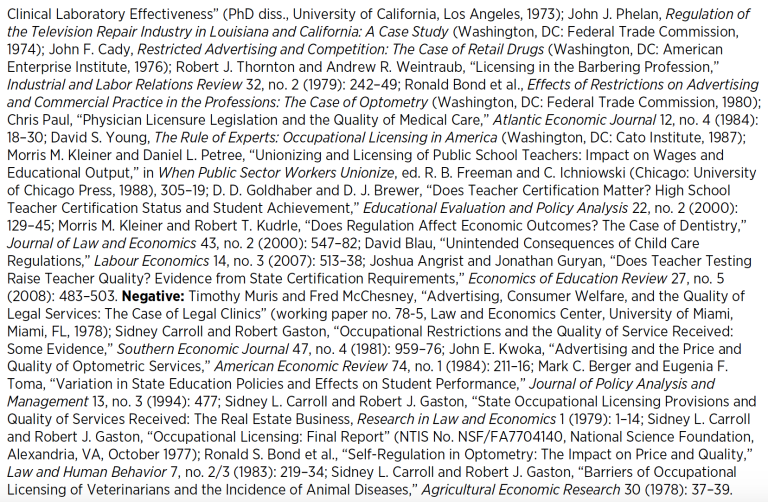
There is abundant evidence that licensure raises prices. Economic theory is unambiguous: supply restrictions such as licensure tend to raise prices. And the evidence supports this theory. In a Mercatus assessment of 19 peer-reviewed studies, my colleagues and I found that licensure was associated with higher prices in all 19 studies. Reviewing many of the same studies, Obama administration officials similarly concluded that the association between licensing and higher prices is “unequivocal.”
Successful Reform Is Difficult but Not Impossible
Licensing reform efforts are difficult to implement successfully. The consumers and the aspiring professionals who suffer from anticompetitive licensing regimes are numerous and typically politically unorganized. On the other hand, the industry insiders who benefit from these regimes are comparatively few in number and typically well organized. Economists and political scientists have long blamed this pattern of diffuse costs and concentrated benefits for the persistence of inefficient and inequitable policy. And this pattern has made licensing reform an uphill battle, even though experts across the political spectrum tend to agree that current licensing laws are inefficient and anticompetitive.
Drawing lessons from successful reform. Despite the advantages enjoyed by special interests, history affords a number of examples in which the general interest has prevailed. In areas as varied as trade, race relations, and airline policy, special interests have occasionally lost their privileges while general and diffuse interests have benefitted from a more level and open playing field.
There are a number of important lessons to draw from these cases. But perhaps the most important is that institutional reforms must permit policymakers to cast conspicuous votes in the general interest and limit the power of special interests to dominate the process.
Arizona has already pursued a number of important institutional reforms of occupational licensure, including the right to earn a living and universal license recognition.
Because licensure imposes particularly steep burdens for peripatetic military personnel and their spouses, a number of states have moved to ease that burden for this particular population. The most common approach, adopted by every state but Connecticut, is to somehow recognize out-of-state licenses of current or former military personnel, their spouses, or both. This can take a number of forms. In Tennessee, Texas, and Utah, for example, active-duty military personnel and their spouses may work without a license so long as they possess a valid out-of-state license. In the other 46 states that recognize out-of-state licenses, state agencies must grant in-state licenses to those military personnel and their spouses who currently possess valid out-of-state licenses.
In 32 states (shown in figure 3), regulators are required to conduct an expedited review process in order to determine the validity of out-of-state licenses. In 35 states (shown in figure 4), regulators are required to issue temporary licenses during the review period. These temporary licenses can be helpful because they permit recently relocated members of the armed forces or their spouses to get to work right away.
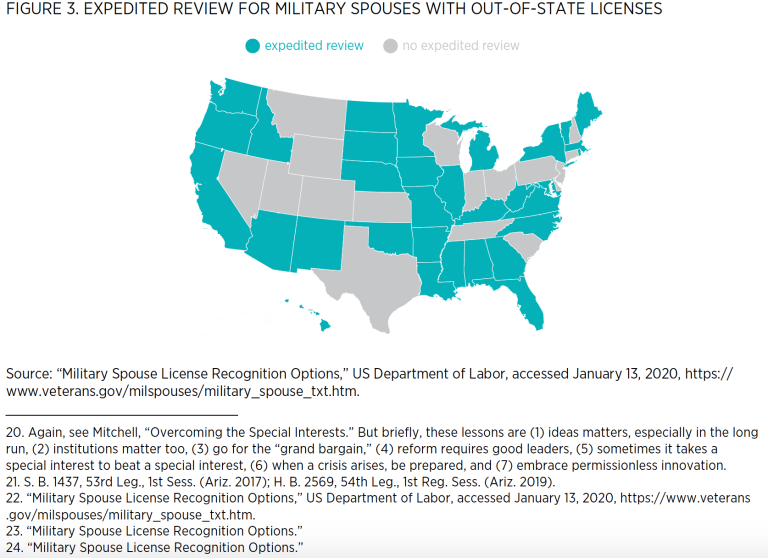
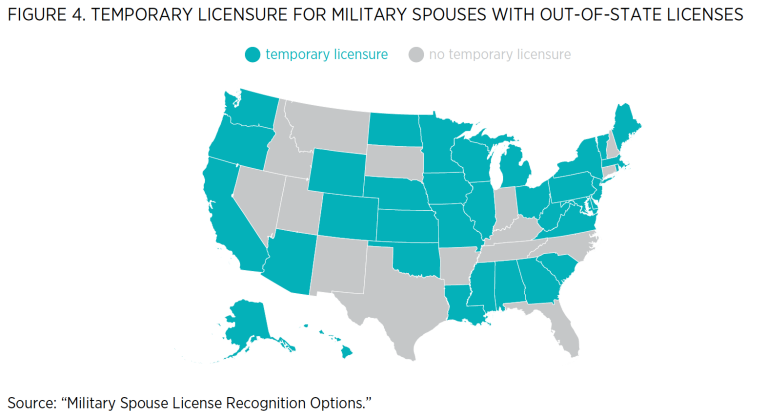
HB 2288 in Arizona would further ease the burden of licensure for low-income individuals, active-duty military personnel, military spouses, and veterans by waiving licensing fees for these individuals. While this approach is certainly beneficial for this population, it fails to alleviate the burden borne by most licensed workers.
Policymakers who value consumer protection, lower prices, and greater opportunity for employment—especially among lower-skilled and lower-educated populations—would do well to consider these reforms.
Thank you for the opportunity to share my research with you today. I look forward to answering any questions you may have.